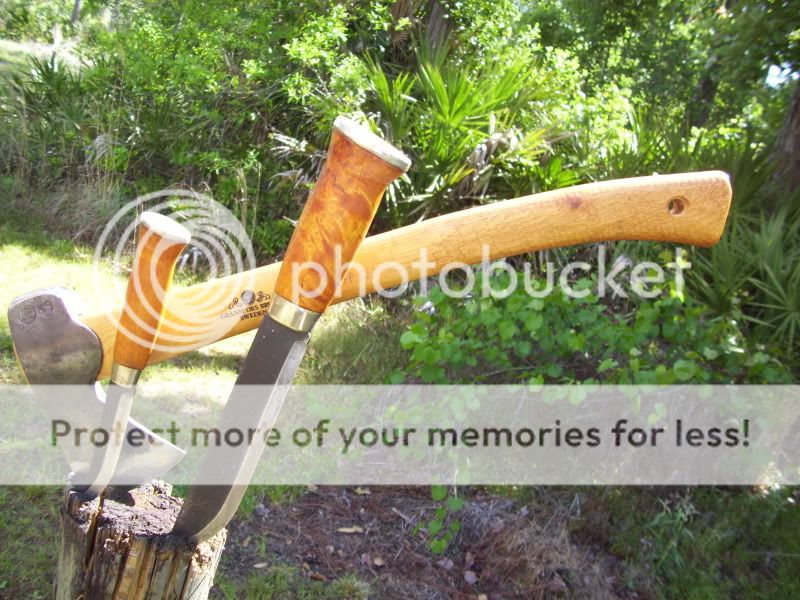First let me say that if anyone thinks I'm calling them out, I'm not, I'm just going to post a lot of stuff in one post.
[Stepping On Toes]
If you are going to only carry one tool in the bush -- for camping, bushcrafting, or living -- you're a fool. There, I said it.
[/Stepping On Toes]
Now, people seem to be thinking only of conventional knives as choppers. Personally, long knives, I don't consider very good choppers. I carry them, but I carry them for other purposes. However, I'm going to compare to saw to
real choppers -- axes, machetes (the whole family) and kukri.
When you talk about real choppers, rather than just a long knife, you're in different territory. I've posted these before, but for sake of argument, here's my favorite combos, and their choppers:
Be advised, in the bottom pic, the
tomahawk is the chopper, not the knife.
With any of the choppers in that pic, I will get through wood faster and with less effort than with one of those pruning saws guys love so much. When you get to wood that's big enough that those won't work well, then you're at the size of wood where your pruning saw won't work either. With choppers like those, you don't just flail away. If you're flailing away, then sure, you're going to think the chopper takes more effort than a saw -- but it's because you're using the chopper in the most inefficient way possible. You use gravity and technique when chopping, not brute strength. Your muscles
start the chopper, and
guide it to its target. My arm and shoulder hurt a lot more, and I'm breathing harder with a saw than with any of the above choppers.
Safety? Well, I've cut myself almost every time I use a small saw. I've never cut myself with a chopper. If you are talking about safety while swinging away, then if you just keep any body parts out of the way during the swing, AND the follow-through, you won't hit yourself.
The other complaints I see is axes that don't chop well because of obtuse edges. That's not the tool's fault, it's the guy who sharpened its fault -- whether the owner or the guy at the factory. While we are on the subject, does anyone teach axe skills anymore? It was a big deal when I was a Scout to learn axecraft. First thing you had to learn was how to put a proper edge on it, and you did it with a stone, not a belt sander. You also learned to hew with the axe (or hatchet if you prefer), so that you could get fairly straight sides to a cut and whatnot. The poster above is right: a lot of people who used axes a lot will tell you to use a 3/4 or full size axe for bucking and limbing and the hatchet for hewing. When you split with a hatchet, you don't swing it at the end of the round, you place the bit on the side near one end, and slam both into another log to set the bit, and then a quick twist splits the rounds. or, you can place the hatchet on the end of a round, slam both down to set the bit and then pick both up together and bring them down to split. If you need to split something large you use a two-handed axe, or you use wedges and such with the hatchet to split. To make straight sides, you place the hatchet where you want to hew, with one side of the bit square to the piece you are going to keep, and use a baton on the poll to progressively hew away the uneven edge.
Those techniques also work with the hammer poll, or plain poll hawk or kukri, and all but the splitting work with a machete as well. using a baton for detail work takes away that factor of safety concern as well.
Using a baton to fell, split and hew with a long knife works as well, and provides good control for minimal effort and plenty of safety.
The only real downside to the big choppers is that you have to develop a skillset to use them well. But the up side is, that once you have that skillset, you have a more versatile, easier to maintain tool.
Carry what you like, but don't disparage what the other guy uses.




